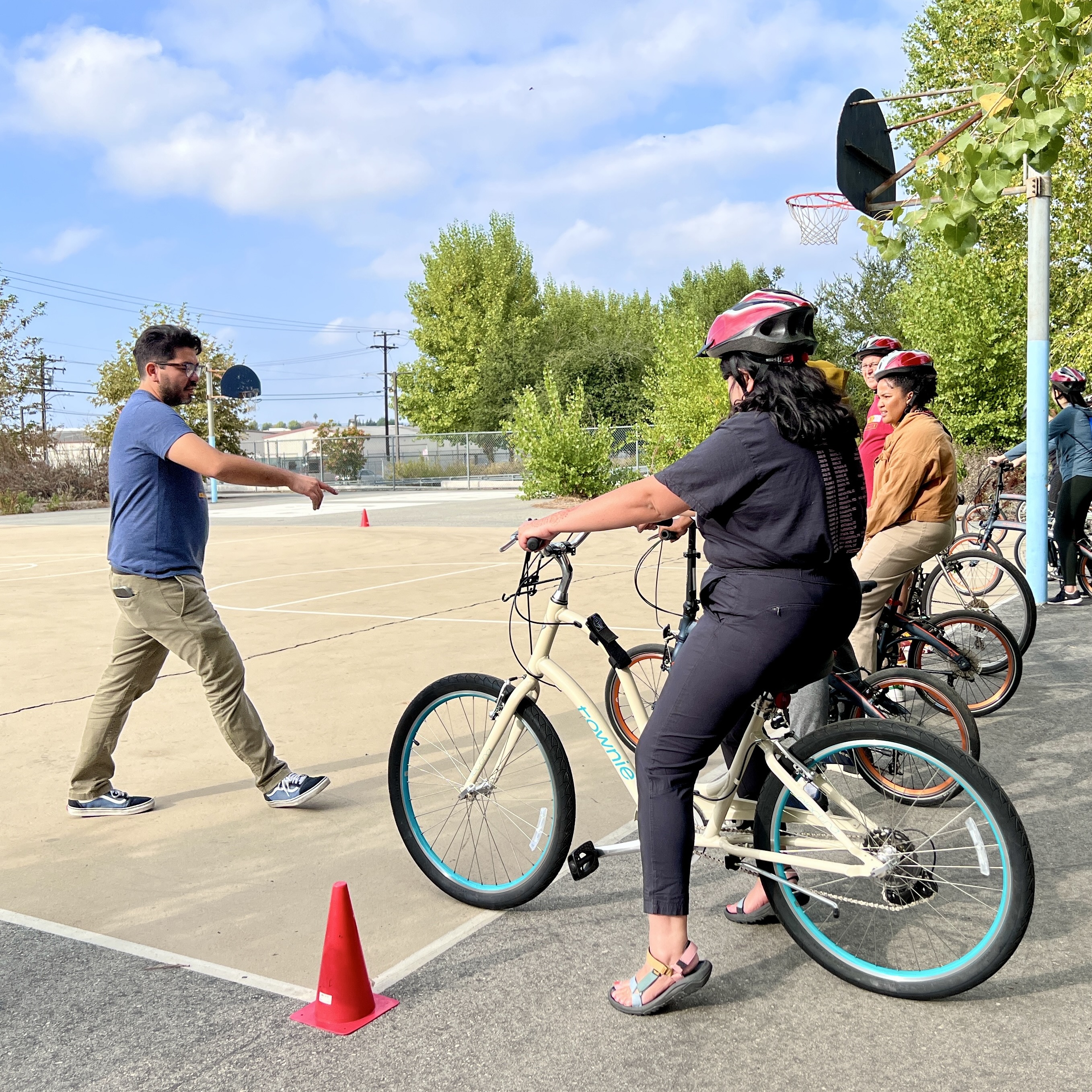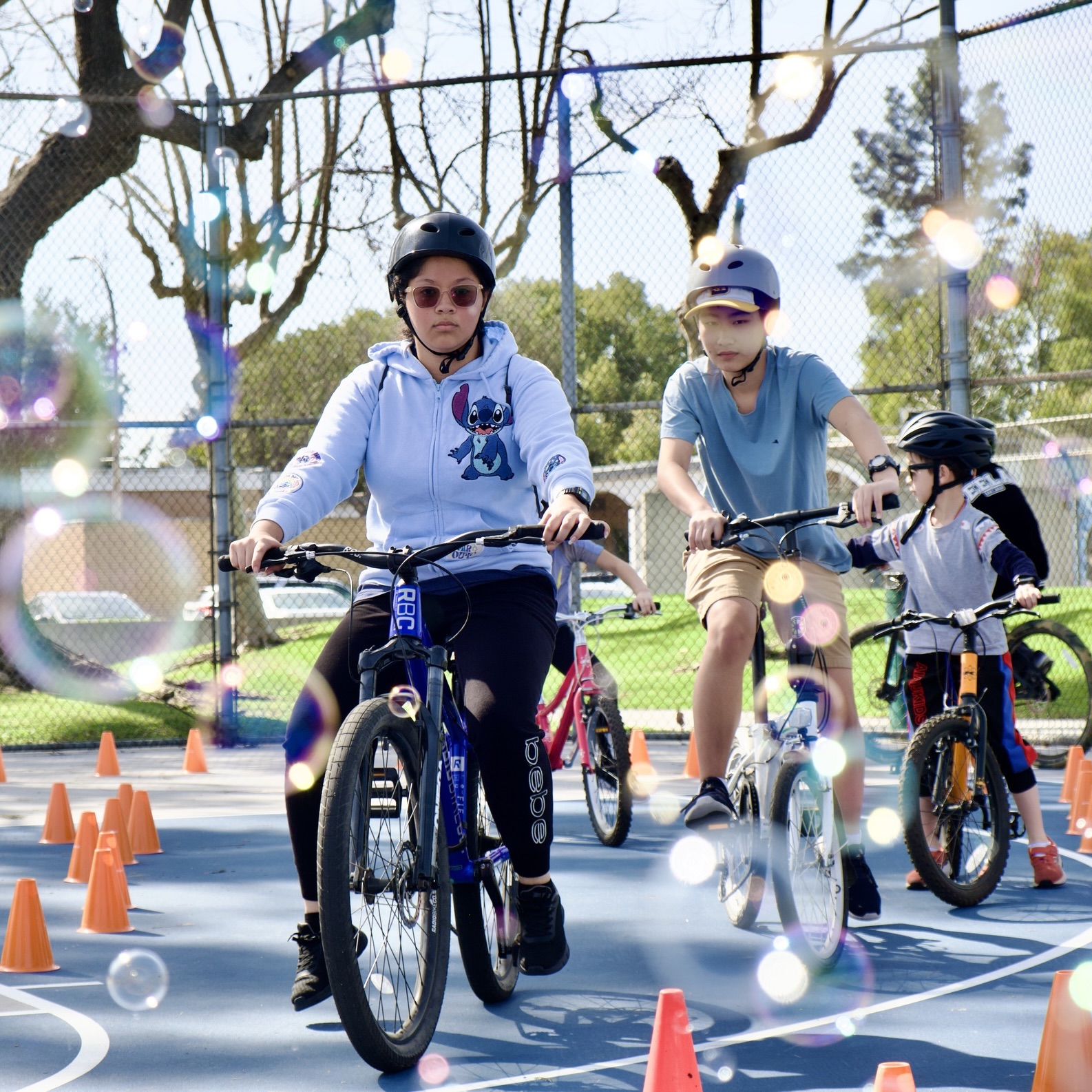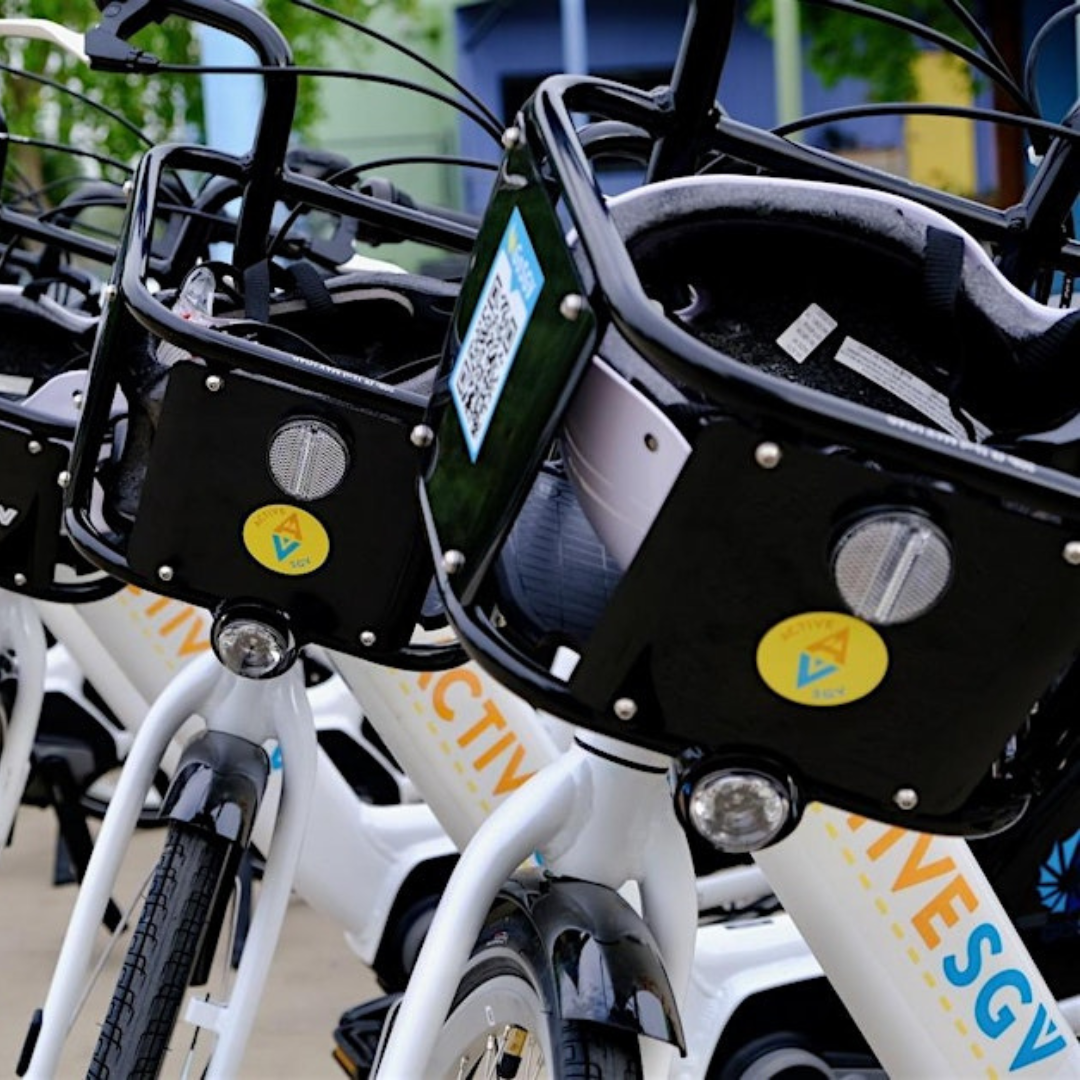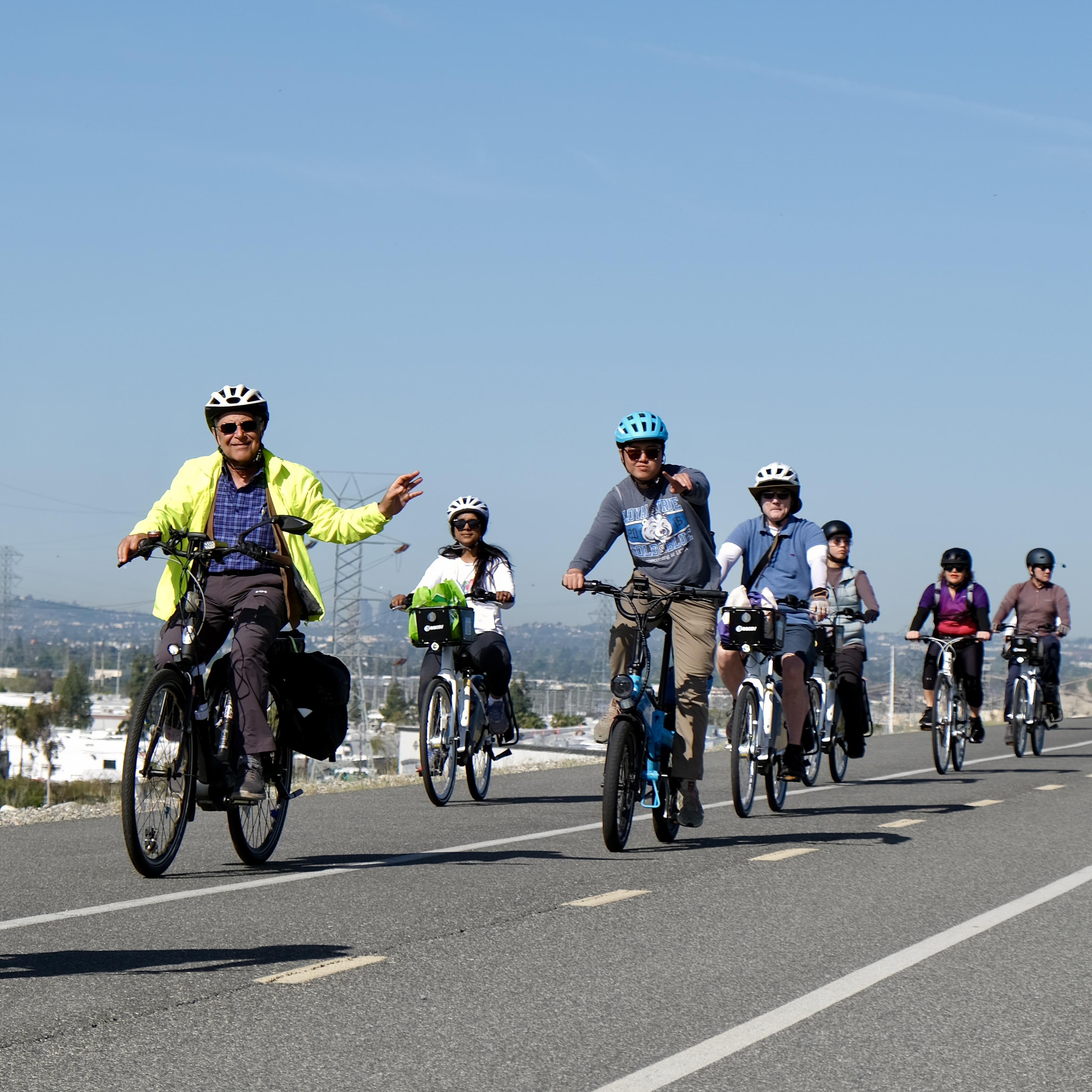Biking the San Gabriel Valley
The San Gabriel Valley is home to over 30 jurisdictions, many of which are small in size and lack bicycle planning or infrastructure of any sort. Local residents that wish to cycle tend to cross multiple jurisdictions when commuting to work, shopping or conducting everyday tasks, increasing the importance of developing city-level bike plans that will form a cohesive, inter-connected network of bicycle infrastructure for the region.

Existing City Bike Plans
The following cities in the SGV currently have active transportation plans. ActiveSGV was intimately involved with the development of 10 of these plans, identifying and securing funding for their development in two multi-jurisdictional phases, and supporting community outreach and engagement in plan development.
- Baldwin Park
- Claremont
- Duarte
- El Monte
- Glendora
- Irwindale
- LA County Unincorporated
- Monterey Park
- Monrovia
- Montebello
- Pasadena
- Pomona
- Rosemead
- San Dimas
- San Gabriel
- South El Monte
- South Pasadena
- Temple City
SGV Regional Active Transportation Planning
Phase 1 - San Gabriel Valley Regional Bicycle Plan (2012-2014)
In early 2011 this reality prompted ActiveSGV organizers to recognize that the region was an ideal candidate for a regional master plan, similar to the one developed by seven South Bay cities in 2010-11. In the following 2.5 years ActiveSGV educated local decision-makers, key stakeholders, and members of the public about the merits of regional coordination in the San Gabriel Valley in the realm of bicycle planning, while simultaneously seeking funding opportunities to make this vision a possibility for communities without the resources to individually hire bike master plan consulting teams. Examples included the submission of a CalTrans grant proposal by the City of Baldwin Park in April 2012 which included the Cities of El Monte, South El Monte and Monterey Park.
Three months later in July 2012, ActiveSGV joined forces with SGV-based public health non-profit Day One, Inc. and five cities - Monterey Park, San Gabriel, Baldwin Park, El Monte and South El Monte - to submit a grant proposal to the Los Angeles County Department of Public Health's PLACE Program. One of over forty proposals submitted, the San Gabriel Valley Regional Bicycle Plan initiative was invited in fall 2012 to the round of 16, which consisted of a panel interview. The aggregate scores of the collaborative's written proposal and interview were then tabulated and ranked. At the end of the process, the Day One/ActiveSGV led proposal was incredibly fortunate to finish among the elite 8 and receive very competitive federal grant funding.
Project Goals
- Promote bicycling as a means to decrease childhood and adult obesity resulting from lack of physical activity;
- Develop a Bicycle Master Plan that creates an accessible network of bicycle infrastructure and connects the participating San Gabriel Valley cities to one another other and to greater Los Angeles County for the general benefit of all County residents;
- Facilitate the implementation of Master Plan projects; and
- Develop a youth-focused bicycle cooperative.
Phase 1 Timeline
The project kicked off on May 15, 2013 and concluded when the 5th and final City adopted its completed Bike Plan in Fall 2014. Unfortunately Congressional budget cuts ended the program's funding two years into a four year program. As a result, ActiveSGV was not able to complete project goals 3 and 4 listed above as part of the project. However, ActiveSGV staff was able to successfully complete a fundraising initiative to launch the SGV Bicycle Education Center at the Jeff Seymour Family Center in El Monte in 2016.
For more info, or to download a copy of the final plan, visit the SGV Regional Bike Plan Website.
Phase 2 - San Gabriel Valley Regional Active Transportation Plan (2017-2019)
Designed to build upon the successful 5-city bike plan unanimously adopted by the Cities of Monterey Park, Baldwin Park, El Monte, South El Monte and San Gabriel in 2014, this follow-up effort developed local "Active Transportation" Plans (i.e. biking AND walking plans) to five SGV communities without: the Cities of Montebello, La Puente, Irwindale, Glendora and Monrovia. The regional effort also included a Greenway Feasibility Study to identify the 50 miles of storm channels best suited for short-term greenway development, as well as 50 bicycle safety classes, over a dozen pop-up bike light distributions, and robust community engagement.
Phase 2 Timeline
The planning process was launched in Spring 2018 and concluded in Fall 2019. For more info, or to download a copy of the final plan, please visit the SGV Regional Bike/Ped Plan Website.
SGV Cities – State of Bike Planning
Alhambra
After a concerted effort by local residents, cyclists, and advocates, the City of Alhambra hired Alta Planning to develop its first Bicycle Plan in early 2012. An initial draft plan - which called for a system of Class III Bike Routes and 7 miles of Class II Bike Lanes - was released to the public in October 2012. Yet the draft, Class-III-Bike-Route-heavy plan was never adopted by the Alhambra City Council. At present the City does not have any Class I Bike Paths or Class II Bike Lanes, and few bicycle routes or parking spaces in its commercial districts.
Since then Alhambra voters have elected several new Council Members, including Jeff Maloney, Adele Andrade Stadler, and Sasha Rene Perez who have publicly advocated for and supported safer streets for walking and bicycling. This infusion of new leadership made it possible for ActiveSGV staff to receive Alhambra City Council support to participate in an Open Streets event with the neighboring cities of San Gabriel and South Pasadena. "626 Golden Streets - Mission to Mission" was successfully staged in the community on May 19, 2019, drawing tens of thousands of residents and visitors to Alhambra's Main Street. Thanks to the popularity of the event with local residents and stakeholders, in 2021 ActiveSGV staff worked with the three communities and SGVCOG to submit an application to the Metro Open Streets program to stage the event again in 2022. Also in 2021 ActiveSGV staff partnered with residents of Poplar Blvd to implement a traffic safety demonstration. The project -- Reimagine Poplar - included temporary, high-visibility crosswalks, curb extensions, and a bike lane.
More Info

Arcadia
On March 5, 2017 the City of Arcadia joined 7 of its neighbors in participating in the inaugural 626 Golden Streets ciclovia. In 2019 the City of Arcadia striped 7 miles of new, dedicated bike lanes on city streets -- including Huntington Drive and 2nd Street -- building upon its first few bike lanes on Santa Anita Avenue and segments of Colorado Blvd.
The City does not have a Bicycle Plan; in March 2012 the City Council rejected a staff recommendation to hire a consulting firm to develop one, citing that bicycling was a recreational activity, not meaningful form of transportation.

Local Bicycling Routes
The challenging and winding 3.4 mile climb to Chantry Flats is a favorite among local recreational cyclists. The campground at the end of the road is also a popular staging ground for mountain bicycling.

Baldwin Park
The City of Baldwin Park has quietly made progress in creating safer, healthier streets in the San Gabriel Valley. In 2011 the City was one of the first in Los Angeles County to adopt a local "Complete Streets" policy. In spring 2012, the City also took the lead in applying for a CalTrans Environmental Justice grant to fund the development of a regional bicycle plan with the cities of Monterey Park, El Monte and South El Monte. While that effort was not funded, the City also joined the successful five-city proposal submitted in August 2012 that resulted in the launch of the San Gabriel Valley Regional Bike Master Plan initiative in May 2013. In November 2014 the City joined Monterey Park, El Monte, South El Monte and San Gabriel in adopting the SGV Bike Plan.
In 2018 the City redesigned a first section of Maine Avenue, a project which included parkways with new street trees, stormwater capture elements, a Class II bike/roll lane, curb extensions to shorten crossing distances for pedestrians, and high visibility crosswalks. In 2018 the City also hosted its first ciclovia, “Pride of the Valley Open Streets”, connecting the Civic Center to Santa Fe Dam in the City of Irwindale. In 2019 the City implemented safety improvements to Frazier Street, including traffic calming and Class II bike/roll lanes with high-visibility green paint at conflict zones.
In 2020 Public Works staff — led by Sam Gutierrez and David Lopez — anticipate that the City will implement a Class I Greenway connection to one of the best regional bike/rollways in Los Angeles County, the San Gabriel River Trail. The project, five years in the making, is fully-funded by a very competitive state Active Transportation (ATP) award. Also in the works are extensions of the successful Maine Avenue Complete Streets project. Planning and design is underway for Phase 1B to connect the improvements to the north to Arrow Highway and the south to the West Covina border. City staff also continues to work on transforming the Walnut Creek into a safe, off-street active transportation corridor connecting Hilda Solis Park, the skate park, and the City’s Teen Center to local residential neighborhoods.

Claremont


Covina
In September 2011 the City approved the Covina Bicycle Plan and Downtown Covina Pedestrian and Bicycle Planning Study. 2011 also saw the City be awarded over $800,000 in funding for bicycle lanes on Citrus Avenue, Second Avenue, Badillo Street and Azusa Ave, as well as the development of a second Bike station in the downtown area. In 2019 the City installed over 7 miles of bike lanes.
Covina Bike Station
The Covina Bikestation provides 36 safe, electronically-secured bicycle parking spaces at the Covina Metrolink Station (600 N. Citrus Ave). Accessible 24 hours a day, 7 days a week, the facility requires the purchase of a membership (about $8-10/month) and also offers valet repair services through a partnership with the Covina Valley Cyclery.
Duarte
The City of Duarte drafted its first bicycle plan in Fall 2015. The community also includes one of the only intra-city Class I Bicycle Paths in the San Gabriel Valley. The 1 mile multi-use bike/pedestrian path runs east-west through town along an old trolley right-of-way.
Local Cycling Routes
Encanto Park in Duarte is an immensely popular staging and meeting area in the City for road bicyclists looking to ride the roads of San Gabriel Canyon and/or the San Gabriel River Trail, a Class I bike path linking the City to Long Beach. Most weekend mornings the parking lot fills early, often with cycling groups from all over the region, but there is ample overflow street parking.
Examples of popular road rides from Encanto Park include:
- Cogswell Dam
- Climb to Crystal Lake
- Glendora Mountain Road - Glendora Ridge Road to Mt. Baldy
- SG River Trail to Seal Beach

El Monte
In 2014 the El Monte City Council unanimously adopted its first bicycle plan and Complete Streets Policy. Since then the City has made slow progress towards implementing the plan, striping dedicated bike lanes on sections of Tyler Avenue, Valley Boulevard, and Durfee Avenue. In partnership with ActiveSGV, the City is also pursuing funding for its first on-street, protected bikeways on Parkview Drive (adjacent to Mountain View High School) and Merced Avenue.

El Monte Transit Center
In October 2012 the Los Angeles County Metropolitan Transportation Authority (Metro) opened the $60-million El Monte Bus Station on Santa Anita Avenue. Funded by the Federal Transit Administration and Local Proposition C as a part of the Congestion Reduction Demonstration (Metro ExpressLanes) Program, the facility consists of two-levels and accommodates Metro, Foothill Transit, Greyhound, Rosemead Explorer and the Metrolink Shuttles. The station is also conveniently located along the Class I Rio Hondo River bike path and includes a Metro "Bicycle Hub" that offers secure bicycle parking to commuters.

Glendora
Over the past decade the City of Glendora has transformed its Transportation Division from a small Commuter Shuttle and Dial-A-Ride operation, to one that focuses upon all modes of transportation and is willing to pilot innovative approaches to street design. In addition to preparing for the return of rail transit service to the community -- the Metro L line Pomona extension is currently under construction in the City -- Glendora has advanced a wide array of transportation planning, design, and infrastructure projects in recent years.
Within the realm of mobility planning the City developed and adopted local First-Last Mile Plan and Active Transportation Plans in 2019. On the design and build side it constructed the first phase of an ambitious Urban Trail and Greenway Network along one of several County flood channels that run through the City, the San Dimas Wash.
Amidst a pandemic the City also proved itself among the most nimble in the region in making space for safer, outdoor business on Glendora Avenue within its historic business district. Over the past 18 months 7 outdoor dining ‘parklets’ popped up within the Glendora Village, as well as two demonstration pedestrian plazas on Meda Street. At first temporary in nature, these installations provided a lifeline to eateries during a very challenging period for small businesses. The expanded outdoor dining also proved so popular with the general public (and participating businesses which subsequently experienced their best year ever in terms of sales) that the City Council invested in upgrading the temporary parklets to safer, more accessible and colorful semi-permanent models made with steel and pine decking.

The City also embarked on a five-month demonstration of first/last project concepts along Glendora Avenue. The demonstration project provided excellent feedback and engagement by reaching over 550 community members as well as a way to learn about real-world design issues. The City is looking to capitalize on this momentum with its ambitious People Movement Project, which is a proposed build-out of nine miles of active transportation infrastructure as well as links to the neighboring communities of Charter Oak and Covina.
Irwindale
The City adopted its first Active Transportation Plan in 2019 as part of a 5-city regional planning effort facilitated by ActiveSGV and the SGVCOG. As of December 2021 none of the plan had been implemented.

La Puente
The City of La Puente adopted a local Active Transportation Plan in 2019 as part of a 5-city SGV regional planning effort facilitated by ActiveSGV and the SGVCOG. More information can be found on the project website here.
Monrovia
The City adopted its first Active Transportation Plan in 2019 as part of a 5-city regional planning effort facilitated by ActiveSGV and the SGVCOG. Since then the City has begun implementing elements of the plan.
Monterey Park
Monterey Park adopted its current Bicycle Plan in December 2014. The lead project City for the 5-City SGV Bike Plan, the City and its elected leaders were initially very supportive of making local streets safer for people on bikes and foot. Unfortunately implementation of the plan has been piecemeal, with few dedicated bikeways installed since 2014.
Previous to the City's adoption of the SGV Bike Plan, its most recent bicycle plan was adopted in 1975. That plan mainly consisted of Class III Bicycle Routes, which consist of green "Bike Route" signage.

Pasadena
In 2011 the City of Pasadena updated its bicycle plan as one element of the General Plan update process. A part of the "Mobility Element", the resulting final draft has yet to be formally adopted by the City, whose various Commissions continue to work on the General Plan's other proposals. The draft plan was heavily reliant on emphasized Class III Bike Routes and "Enhanced Bike Routes" rather than Class II Lanes or Class I paths. The former may consist of signage "Sharrow" street markings (maps of existing and proposed changes can be seen below). While a step in the right direction, Class III infrastructure does not provide the same safety and ridership benefits as Class I/II road treatments, leading local cyclists, in particular members of CalTech's "Bike Lab", to petition the City to improve east-west corridors for cyclists by striping bike lanes.
Implementation of improvements has been slow but steady. Pasadena is developing a network of 'neighborhood greenways' or 'roseways'. The City is in the midst of designing and installing its first Class I, on-street protected bikeway, in response to the education efforts of the Pasadena Complete Streets Coalition, of which ActiveSGV is an active member. In Spring 2014 staff hired KOA Corporation, which designed the successful Long Beach and Temple City protected bikeways, to study the feasibility of such robust improvements on a half dozen potential east-west and north-south corridors in Pasadena, including Colorado Blvd., Green St., Orange Grove Blvd., and Del Mar Blvd. City staff ultimately selected Union Avenue for the City's first protected bikeway facility, and were awarded over $6 million in state grant funding to implement it. Construction is expected to take place in 2022.
Resources/Links
- A Century of Bikes - Final Pasadena Bicycle Plan, November 2000
- Pasadena Bicycle Transportation Action Plan, August 2015
Local Bike Shops
- Around the Cycle
- Pasadena Cyclery
Local Bike Routes/Rides
- Rose Bowl Ride - This historic road training ride (high intensity) around the Rose Bowl loop has been going on for over 60 years. Held Tuesday and Thursday evenings during daylight savings time, the ride begins at 6PM and consists of laps around the Bowl.

Rosemead
The City of Rosemead adopted a Bicycle Plan in March 2012. The City's plan can be viewed/downloaded below, as well as on the City website here.
San Gabriel
The City adopted its first Bike Plan in 2014 and has implemented a few Class II lanes outlined in the plan, including dedicated facilities on a segment of Las Tunas Blvd and Del Mar Ave. In 2019, the City also participated in its first open streets event, 626 Golden Streets - Mission to Mission.

San Marino
San Marino currently does not have a bicycle plan. However, thanks to its many tree lined, well-maintained residential streets, the City is frequented by recreational cyclists, who can often be seen riding in groups through town on the weekend. The weekly Saturday Montrose Ride also traverses town at a high rate of speed via Huntington Drive, despite the fact that it is arguably the City's least pleasant street to ride a bike on.
The City is bisected by Huntington Drive, a regional thoroughfare that recently received Class II Bicycle Lanes in the City of Los Angeles. The cities of South Pasadena and Alhambra have planned extending these bike lanes along their stretches of Huntington Drive to the west of San Marino. In 2014 the City striped Class II bicycle lanes on Del Mar Ave, from the San Gabriel border to Huntington Drive.
In 2014 the City hired Ryan Snyder Associates to develop its first Pedestrian and Bicycle Plan. A draft plan was developed and circulated in the community, but was never adopted due in part to local fears that bikeways would attract "outsiders" to the community.
Local Bike Shops
Worth Checking Out

Sierra Madre
The City of Sierra Madre currently does not have a Bicycle Plan. The City did, however, stripe its first dedicated Class II bike lane on Sierra Madre Blvd in 2020.
Bike Sierra Madre, a local group founded by resident and Boy on a Bike blogger John Lloyd, is active in town working to improve bicycle safety.
The City is also the end of the (in)famous Montrose Ride, one of the, if not the, oldest and largest weekly group rides in the San Gabriel Valley. After traversing much of the San Gabriel Valley - from La Canada Flintridge to San Dimas and back - the ride concludes every Saturday in the heart of downtown Sierra Madre at the corner of Sierra Madre Blvd and Baldwin Ave.
South El Monte
In 2011, the City of South El Monte submitted a proposal to receive Metro Call for Projects funds for several bicycle infrastructure projects. The impetus for the application was a need to create regional non-motorized transportation connections between the City of South El Monte, the El Monte Transit Center, and the Whittier Narrows Recreation Area. The three primary corridors proposed to receive bicycle facilities were Merced Avenue, Tyler Avenue/Santa Anita Avenue, and Thienes Avenue. Merced Avenue would become a Class III bicycle route, while Tyler Avenue/Santa Anita Avenue and Thienes Avenue would receive Class II bike lanes.
In 2014 the South El Monte City Council unanimously adopted its first bicycle plan. The City also adopted a Vision Zero Resolution and Complete Streets Policy. Since then the City has made steady progress in implementing the plan. In June 2017 South El Monte completed development of the San Gabriel Valley’s second protected bikeway on Durfee Ave, going above-and-beyond the standard Class II bike lane proposed in the 2014 plan, and thereby creating a much safer connection for people on bikes to access Whittier Narrows, the San Gabriel River, the City's commercial corridor. The Complete Streets project also included stormwater capture elements, including a permeable center median, native plants, and bicycle lane protected by stormwater capture bioswales.

Not one to rest on its laurels, the City partnered with ActiveSGV, the Council for Watershed Health, and Climate resolve in 2019 to launch the Merced Avenue Greenway project, an effort to create a cooler, greener, safer street that will capture and clean stormwater, provide safe space for people on foot and bike, and accommodate existing vehicle traffic. After completing a community-led design process that resulted in a request for a sidewalk-level, raised protected bikeway, the project team has secured over $5 million in funding to make the vision a reality.

South Pasadena
In 2011 the City of South Pasadena adopted a new Bicycle Plan. The plan calls for over 12 miles of Class II Bike Lanes, in addition to those already found on Marengo Ave. Plan implementation has been checkered in the past decade. Class II Bike Lanes have been installed on Pasadena Ave. and El Centro St. An extension of the Arroyo Seco Multi-Use path, which presently runs several miles along the streambed south of City in Highland Park and terminates at by the York Ave. bridge, was completed in 2019. Other streets slated to receive improvements include Huntington Dr. (Class II Bike Lanes), S. Fair Oaks Ave (Class II Bike Lanes south of Monterey rd), and Monterey road (Class II Bike Lane west of Pasadena Ave).

Temple City
In March 2011 Temple City adopted its first Bicycle Plan. Until that point in time the City did not have any dedicated bikeways. Local cyclists did, however, benefit from the community's flat topography, compact size, and proximity to the Class I Rio Hondo River path. At its time, the 2011 plan was one of the strongest and most comprehensive in the San Gabriel Valley.
In May 2014 the City officially celebrated the completion of the Rosemead Boulevard Project, which included one of the first on-street, protected bikeways in southern California. Unfortunately an effort to similarly transform Las Tunas Drive into a greener, safer, more vibrant corridor was shelved in 2016 after community concern about slowing down vehicle traffic.

West Covina
The City of West Covina currently offers local cyclists a network of Class I, II and III bicycle infrastructure. The City's Class I Bike Path is 2.19 miles along the middle stretch of Walnut Creek. In 2018 the City adopted its first Active Transportation Plan.




.png)




